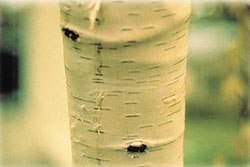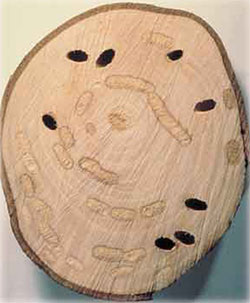
Borers, insects that develop underneath the bark of woody plants, attack many shade and ornamental trees. Most borers attack trees weakened by drought, mechanical injury, recent transplants, poor soils or root systems. The most important prevention of borers is keeping trees healthy through proper management.
Proper management includes watering trees long enough for moisture to reach the root system of the plant, wrapping young trees from November to April to prevent sun scald, and pruning dead or dying branches to discourage insects.
 Some common tree borers include lilac and ash borers, peach tree borer, mountain pine beetle and ips beetle, pinyon pitch mass borers and Zimmerman pine moth. The most common way to control borers, in addition to proper tree maintenance, is chemical control. But borers live inside trees, and treating them with insecticides is difficult. The best time to control borers is when adult are laying eggs on or under bark. Pheromone traps, available for some borer species, help determine if adults are present. Trunk sprays can be effective when borers are in the early larvae stage before they enter the tree.
Some common tree borers include lilac and ash borers, peach tree borer, mountain pine beetle and ips beetle, pinyon pitch mass borers and Zimmerman pine moth. The most common way to control borers, in addition to proper tree maintenance, is chemical control. But borers live inside trees, and treating them with insecticides is difficult. The best time to control borers is when adult are laying eggs on or under bark. Pheromone traps, available for some borer species, help determine if adults are present. Trunk sprays can be effective when borers are in the early larvae stage before they enter the tree.
For more information, see the following Colorado State University Extension fact sheet(s).
- Mountain Pine Beetle
- Shade Tree Borers
- Peach Tree Borer
- Insect and Mite Pests of Honeylocust
- Zimmerman Pine Moth



